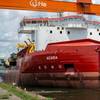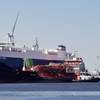Technical advances in the offshore industry and regulatory developments have spurred an update of the ABS Guide for Certification of Drilling Systems. First published in 1985 and last updated in 1990, the Guide references current standards and the recommendations of American Petroleum Institute (API). Importantly, the new Guide provides industry with an option for a “Safety Case” or risk-based analysis approach to certification, rather than applying the more traditional prescriptive rules reflected in the 1990 version of the Guide, says Merih Unuvar, ABS project leader and principal surveyor.
“We’re offering drilling unit owners and builders a more streamlined approach to ABS classification, with the option of certifying the drilling system,” said Unuvar.
He adds that with continued changes in regulatory regimes, the certification of drilling units including the drilling systems is expected to further evolve.
“Our investment in the new Guide readies the industry for ongoing regulatory and technological developments,” said Unuvar.
ABS’ market share for rig classification is around 76 percent of the worldwide rig fleet, representing 512 drilling units classed with ABS. Twenty of the units built since 1990 include the ABS Class Notation CDS.
ABS certification continues to provide the offshore industry with an option for certification on behalf of regulatory authorities, such as the UK Health & Safety Executive (HSE) and the Norwegian Petroleum Directorate (NPD).
“We’re reducing the burden on regulatory documentation for industry, eliminating duplicative steps. That is, if a unit is classified by a recognized society, industry can expect it to be in compliance with most international regulations,” said Unuvar.
Unuvar advises that four new-build GlobalSantaFe drilling units contributed to an immediate need to update the ABS Guide and provided a model for industrywide application. The participating units, all built in Singapore yards, include two semisubmersibles, “Development Driller I” and “Development Driller II,” and two jack-up units, “Constellation I” and “Constellation II.” “Constellation I” delivered in mid-July and is under contract in Southeast Asia. “Development Driller I” and “Constellation II” both deliver toward the end of first quarter 2004, with the balance of rigs to deliver in 2005. All of the rigs, advises Unuvar, include ABS certification of the drilling system.
“Industry will reap the benefit of the lessons learned on this project with more cost-efficient rig certification,” said Unuvar.
Drilling equipment vendors and a number of drilling companies are contributing to the effort as well, says Unuvar, reviewing the Guide and providing feedback for its improvement.
Some of the major changes introduced into the new Guide are summarized below:
• Issuance of Independent Review Certificate (IRC) by ABS engineers is replaced with Product Design Assessment (PDA) certificates offered by ABS’ Type Approval Program.
• Issuance of Certificate of Conformity (COC) and ABS surveyor review of a manufacturer’s data-book is no longer required for ABS classification.
• The ABS Type Approval Program is given more extensive coverage because most of the drilling system equipment is easily certified based on PDA and a manufacturer’s option of either Type Approval (TA) or Quality Assurance (QA), depending upon extent/frequency of vendor assessments by ABS. This option is in lieu of product certification by ABS surveyors.
• Type Approval certification will place the particulars of the designer or manufacturer, product type, model number(s), etc. on the ABS’ website www.eagle.org/typeapproval. The website offers free downloadable certificates to the industry.
• Risk assessment and recognition of risk-based alternatives are introduced into the guide, along with risk-based surveys for maintenance of class, as is consistent with the most recently issued ABS guides.
• References to issues such as fire-fighting, fire-detection, safety, substructures, etc. are removed because industry can follow the requirements in the ABS MODU Rules.
• The original core Table of the Guide with multiple columns and certification codes is revised to now include only two columns: one for an engineer’s required review and the other for a surveyor’s required attendance at a manufacturer’s plant.
• ABS Vendor Coordination department will use the new Table of the Guide to track the status of equipment certification. ABS will provide an electronic format of the table to all parties involved in the certification process. This same table may eventually become the final equipment list of the system installed on a drilling rig.
• All certified drilling system equipment is now required to have a manufacturer’s affidavit, supplied with the equipment, for review by ABS surveyors prior to installation on board the drilling units (not required for submittal to ABS Engineering).
• The guide re-emphasizes the need for an ABS surveyor to attend scheduled maintenance or major repairs. “Release Notes” are introduced for onshore issuance by ABS surveyors to equipment manufacturers before shipment to offshore. These notes are issued subject to confirmatory surveys during scheduled surveys of the rig.
• References to API publications are expanded and updated.
• Requirements specific to NMD/NPD regulations are removed from the guide because the new guide only covers ABS requirements for ABS classification and the class notation CDS (certification of drilling systems), with certification to any other administration or coastal state available upon request.
Copies of the ABS Guide for Certification of Drilling Systems will be available for free from the ABS website at year's end.
Sponsored Content
Safer Starts Here: Build Ships, Protect Crews

July 2025
 Read the Magazine
Read the Magazine

 Read the Magazine
Read the Magazine
This issue sponsored by:

The Golden Ticket – VIP access & invitation to take an active role in History
Subscribe for
Maritime Reporter E-News
Maritime Reporter E-News is the maritime industry's largest circulation and most authoritative ENews Service, delivered to your Email five times per week







